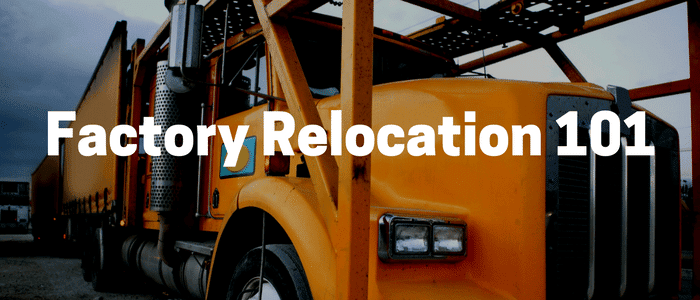Factory Relocation 101: What You Need to Consider Before Relocating A Factory
Crating is an important aspect of any large-scale factory relocation or closure. Are you ready for the task?
When a factory needs to be closed or relocated it’s a huge task for millwrights, riggers and packagers. All the equipment needs to be de-installed, landed, crated and prepared for shipment, usually in a very rapid timeline. We’ve been involved in a number of high-profile relocation jobs and thought we would share some of what we’ve learned. Here are some important questions to ask before you get started.
- Will the equipment be packaged onsite or will it need to be packaged offsite?
- If it is to be packaged offsite, does the facility have enough space to safely house the equipment while crating it?
- What is the optimal size profile of your shipment? Can the equipment be mostly shipped intact or does it need to broken down into smaller pieces?
- How does the equipment need to be prepared for shipment? I.e. fluids drained from the equipment, moving parts secured, weight distributed properly, etc.
- Have you planned for the optimal skids that the equipment requires?
- What hazards will the equipment be exposed to in transit? This is especially important when it comes to trucking, which means potholes and other road hazards.
- Will the equipment be sent by ship? If so, then it will need special protection from prolonged exposure to salt air and moisture. Sealable vapor barrier bags, desiccants, and other techniques might be required if the shipment situation warrants.
- How are the crates getting labeled and what system is in place to make sure that everything is labeled clearly and strategically?
- Are there contractors available on the other end who can safely unpack and install the equipment? What special instructions will they need?
Leave It To The Experts
Craters have specialized skills and tools to crate machinery quickly, securely and without error. The specialized knowledge that craters bring to a factory relocation project is valuable in ways that you might not yet see. From protecting equipment from harmful vibration and corrosion, to making it easy to unpack and install the equipment—specialized packagers are a necessary addition to every relocation job.
What’s Your Timeline?
A major consideration in all packaging jobs is timeline. Some factory relocation jobs are well planned and have generous timelines for millwrights and craters to do their work. But we all know that other jobs come up quickly and need to be done in a rush. For the most rushed jobs, be sure that you have a crating company with enough room in their facilities to house the equipment while crating it. That way, you can land the equipment and get it out of the factory quickly, while craters can work at their location to package the equipment.
We cannot emphasize this enough. The best crating companies to work with are companies that can crate all the equipment in their own facility OR can crate it onsite (or a combination of the two). Many craters to do not have the room in their facility to accept large-scale equipment under their roof. If this is the case, then you’ll be stuck waiting for everything to be crated before it can be removed, and that might push your timeline back, causing expensive delays.
Let Reid Packaging Be Your Factory Relocation Partner
Here at Reid we don’t just dabble in large-scale crating projects, we do them every day. Our 60,000 ft2 manufacturing space enables us to house a huge amount of equipment while we crate it. Of course, we can also do all the crating on site. It’s entirely up to you and to the specific job requirements. This makes us an intelligent addition to just about any factory relocation job in the southern states.
Case in point: we packed the enormous F-22 project at Lockheed Martin. Check it out.
Call us today so we can begin planning your project.

